Launch campaign complete; Farewell to Baikonur
14 April 2016
At 09:31 UTC on 14 March 2016, a powerful Proton launcher lifted off from the Baikonur Cosmodrome, carrying the ExoMars 2016 spacecraft on the first leg of the 500 million km journey to Mars. This marked the high point of an intensive three-month launch preparation campaign that involved many teams from across Europe and beyond. As the mission now moves to a new phase – in-orbit commissioning and the interplanetary journey to the Red Planet – we close out this series of articles by catching up with three of the ExoMars team who have been deeply involved in the launch campaign and asking them to share their reflections of this special period.
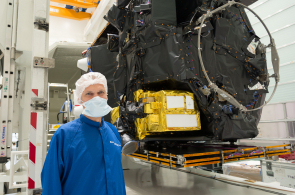 |
| Boris Bethge. Credit: ESA - A. Haldemann |
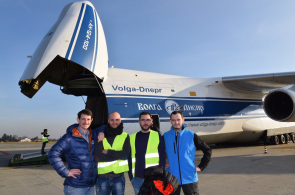 |
|
Albert Haldemann (left) and companions. Credit: Thales Alenia Space |
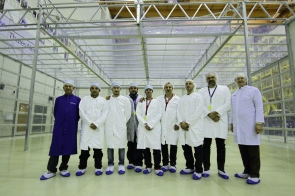 |
|
Joe Pereira (left) and Don McCoy (right) in the cleanroom at Baikonur. Credit: ESA |
Boris Bethge, Albert Haldemann and Joe Pereira have been immersed in the ExoMars 2016 launch campaign for the past few months. The Baikonur cosmodrome became a home-away-from-home for them as they, along with colleagues from ESA, Roscosmos, and Thales Alenia Space, worked to ensure that the ExoMars Trace Gas Orbiter (TGO) and the Schiaparelli entry, descent and landing demonstrator module were ready at the opening of the launch window on 14 March.
Boris is the ExoMars Senior Assembly, Integration and Verification (AIV) System Engineer and he has been involved, for many years and on a day-to-day basis, in monitoring, on ESA's behalf, the building and testing of the TGO and Schiaparelli.
Albert is ESA's ExoMars Payload and AIV Manager, and he too has been closely involved in all aspects of the AIV phase for the spacecraft, in particular in making sure that the science instruments are compatible with the spacecraft and can meet their objectives.
Joe is ESA's launch campaign manager for the ExoMars 2016 mission. He is the person who was tasked with the responsibility of organising and running the campaign in Baikonur.
The launch itself is, of course, the event that remains most vividly in the memory of most of those who were involved in the campaign.
Launch day dawns
Early in the morning on 14 March, long before sunrise, the team members involved in the countdown headed to their posts.
Joe, along with the Proton launch control team, would be closest to the spacecraft and launcher, in the 'bunker', which is situated less than 1 km from the launch pad.
Back in the spacecraft assembly building, some 8 km from the launch pad, the management team from ESA and Thales Alenia Space, including ESA's ExoMars project manager, Don McCoy, and the Thales spacecraft preparation manager, took their places. Joe was connected to this team by audio-video link and was tasked with operating the Launch Abort Button in case of an anomaly on the spacecraft - this would be done in consultation with Don McCoy and would have initiated an automatic launch abort up to 3 seconds before launch. Fortunately no such action was necessary on the day.
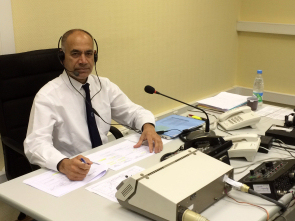 |
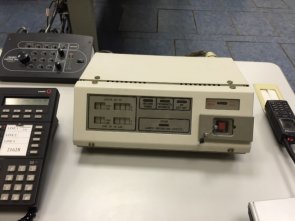 |
| Joe Pereira, ExoMars launch campaign manager. Credit: ESA |
Launch abort system at Baikonur. Credit: ESA |
Close by, in the same building, was the Thales spacecraft operations team, composed of engineers who knew the spacecraft inside-out since they had been involved in the earlier testing phase in Cannes. This team was monitoring the telemetry from the spacecraft (up until the moment of liftoff) and the information that they provided was used by the management team to decide on whether or not to proceed to launch. Boris was with this group, acting as the interface to the ExoMars Spacecraft Operations Manager at ESOC. The team at ESOC were connected by voice loop and were also receiving the telemetry from the spacecraft.
Albert, and other team members who were not actively involved in the countdown that day headed to a viewing platform, located 3.4 km from the launch pad where they were joined by some of the scientists who are responsible for the instruments and sensors on TGO and Schiaparelli, as well as by members of the media and representatives of funding agencies and institutes associated with the mission.
Personal recollections of the launch
"At the moment of lift off, which we could watch on TV monitors, we all ran outside to watch. It was quite cloudy so a bit difficult to see, but the sound of the Proton taking off was incredible," recalls Boris. "And it was quite an emotional moment, to see the spacecraft leaving the planet, after so many years of work."
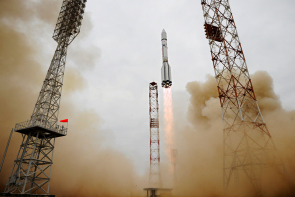 |
|
ExoMars 2016 liftoff. Credit: ESA–Stephane Corvaja, 2016 |
Albert had previously witnessed a launch of the Space Shuttle, but a Proton launch was a new experience for him. "Of the five missions to Mars I've participated in, this was the first one where I've actually seen the rocket take off," he says. "We were standing outdoors, watching the rocket. The weather was overcast and when the rocket went up it was a wonderful view and, surprisingly, it was not as noisy as I expected it to be. I've seen a Shuttle launch from a similar distance, and that was very, very loud! The Proton rose pretty quickly, and the view was a classic launch picture: it looked almost like a 'Tintin' rocket because of the six rocket engines – the Russians call them 'carrots' – that are mounted around the launcher," he continues.
"Once it passed through the clouds, the Europeans who were viewing the launch started applauding, but the Russians – who were more familiar with Proton launches – remained quiet. In fact there were still quite a few steps that needed to happen. Through the loudspeaker someone was announcing – in Russian – as the altitude increased, going to 20 kilometres, 50 kilometres, 90 kilometres. We were listening to this and the announcer was saying 'normalna… normalna… normalna,' all normal. I was quite happy to see the Proton lift off the launch pad, but then I started waiting to hear confirmation that the first stage release happened correctly, and then the next steps: the second and third stage releases, and the jettisoning of the fairing. These were released within 12 minutes, as planned. The Russians only really started congratulating one another when the Proton had released the third (upper) stage."
For Joe, in the bunker, there was no such live view in the open air but, as he says, "The lack of a view was compensated for by a huge vibration sensation as the rocket took off."
Getting to Baikonur: planes, trains, and automobiles (and ships)
The launch was the culmination of an intensive three-month launch preparation campaign that began shortly before Christmas 2015 when three Antonov flights carrying the Trace Gas Orbiter and Schiaparelli, along with all of the support equipment and some crew, departed Turin-Caselle airport in Italy, (on 18, 20 and 22 December) for Baikonur.
Fuel for the spacecraft was procured in Germany and transported by ship and then train to Baikonur. (In fact, the transport of the spacecraft propellant started already back in August 2015, in thermally controlled sea containers.)
Many experts and specialists, some of whom have been working on the spacecraft for many years, and some who were involved specifically for aspects of the launch, made their way to Baikonur, in some cases on the Antonovs.
"It was really quite some work, especially for the people from ESA and also industry (Thales) who organized the launch campaign with all its complicated logistics - they did an excellent job getting everybody and everything to the right place at the right time," says Boris.
All hands on deck at the cosmodrome
A launch campaign is by its very nature a complex operation and the ExoMars 2016 campaign was no exception. One important aspect of the ExoMars mission is that the spacecraft have to satisfy strict planetary protection regulations and Schiaparelli, in particular, which will land on the surface of Mars, had to be frequently controlled to ensure that the microbiological contamination remained at a minimum. A cleanroom suitable for use by the ExoMars project was not available in Baikonur, and this meant that a giant 'clean tent', or mobile cleanroom, also had to be transported and assembled by a specialized crew. "The assembly of the mobile cleanroom was really well orchestrated, like the mounting of a circus tent," remarks Albert.
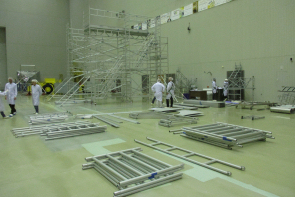 |
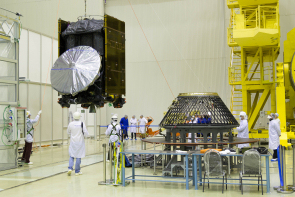 |
|
Building the basics in the cleanroom. Credit: ESA - A. Haldemann |
The Trace Gas Orbiter and launch vehicle adapter. Credit: ESA - B. Bethge |
Making sure that Schiaparelli was free from microorganisms meant that not only did the engineers have to wear 'bunny suits', but it necessitated the presence of an expert microbiological team who regularly took and checked samples. "The main laboratory for testing the samples was in a modern building on the other side of the building where we were with the spacecraft, so they had to hike around the big facility with their samples in the cold, in the middle of the winter," says Albert. "They were pretty dedicated, and did a great job."
The largest contingent preparing for the launch was from Thales Alenia Space, the prime contractor for the ExoMars spacecraft. Most of the ESA team members had experience working with Thales staff and had already spent a lot of time at their facilities. As Joe explains, this familiarity helped: "They understand me and my philosophy, and I understand how they work. This makes for a good working relationship and that really counts in a critical phase like the launch campaign."
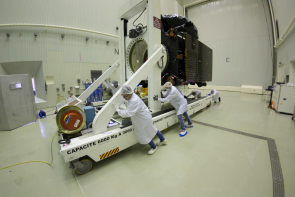 |
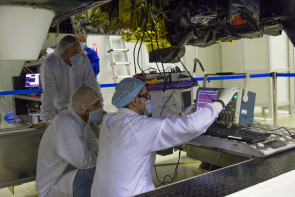 |
|
Moving the Trace Gas Orbiter. Credit: ESA - B. Bethge |
Working on the Trace Gas Orbiter. Credit: ESA - B. Bethge |
Working with the Russian teams responsible for the launch on the Proton at Baikonur was for many among the ESA team a new experience. "There was a common objective and a common purpose, and everybody agreed to it, and this was the basis of this multicultural effort," says Albert. However, the European teams had to get used to the more bureaucratic approach of their Russian colleagues. "Interfacing with the Russian team, especially during the preparatory meetings, took some getting used to," notes Joe. "They are very keen on certificates, and we had to sign about two dozen certificates soon after we arrived, saying that everything was ready on our part, and that their facilities were ready. This is just an example of how different groups work, but we are well used to adapting to cope with new working environments."
One important task of a launch campaign is to find and resolve any remaining system bugs, and – as is always the case – some were found. "We overcame all the problems and still managed to stick to the schedule because we had a little bit of built-in margin which meant that we were able to recover any lost time," says Joe. "We were conscious of the narrow launch window, of just twelve days, but were confident that we would make it."
"At one stage there were some electronics and science instruments that needed fixing, and rather than keeping it one day at a time, the Thales team picked up the pace, working 3 shifts a day for 3 days to fix the problems - this great teamwork kept us on track," adds Albert.
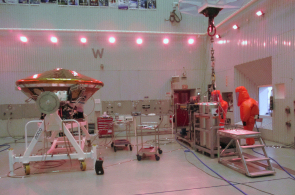 |
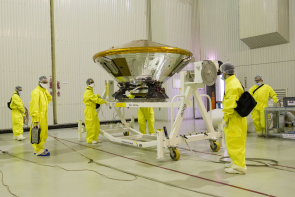 |
|
Fuelling Schiaparelli. Credit: ESA - T. Walloschek |
Working on Schiaparelli. Credit: ESA - B. Bethge |
Keeping to the tight schedule and coping with the hard deadlines does take a personal toll and for some of the team it was especially tough at times: "The long absence from family and friends, especially at the beginning of the Christmas/New Year holiday period, was hard, and for me and many of the Italian team members this was on top of already being away for a long time in Cannes," says Boris. "Of course, a "routine" working week that consists of 11-12 hours a day for 6 days a week (and sometimes Sundays as well) can be tiring too! So it was with a mixture of joy and relief that we watched as the TGO and Schiaparelli were sent on their way to Mars."
"And our Russian partners also had a great sense of satisfaction, and pride, at the successful launch of the mission," adds Albert.
Teamwork triumphs
Launch campaigns are all about teamwork and about people working towards a common goal. The successful launch of the Trace Gas Orbiter and Schiaparelli was possible thanks to the dedication of many people from ESA, Roscosmos, Thales Alenia Space and the many other agencies, companies and academic institutes who have played a role thus far.
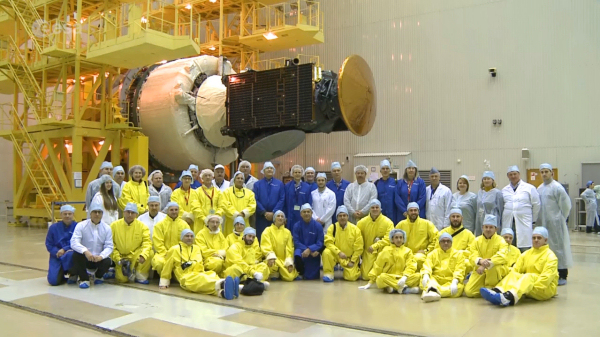 |
|
Some of the many ExoMars 2016 team members in front of the spacecraft at Baikonur. Credit: ESA/Roscosmos/ExoMars |
And a final thought from Joe Pereira, the launch campaign manager? "When I think about this launch campaign I can say that all of the various teams, from the space agencies and from industry, can look back with pride on a job well done in a spirit of friendliness and camaraderie in a very challenging environment."
The final activities of the launch campaign were to gather and pack all of the remaining supplies and equipment, for transport back to Europe.
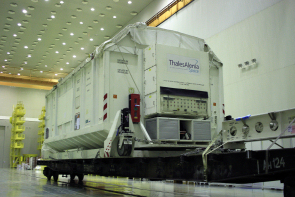 |
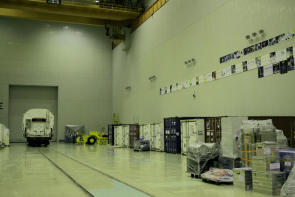 |
| Packing for the trip home. Credit: ESA - R. van Haarlem | |
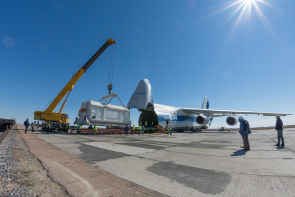 |
 |
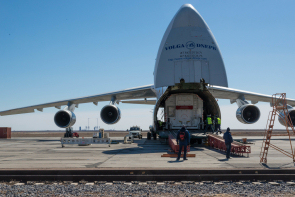 |
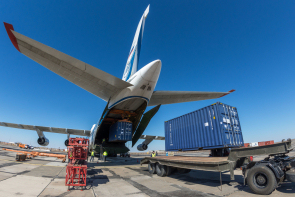 |
| Loading the Antonov 124 at Baikonur. Credit: ESA - B. Bethge | |
Farewell to Baikonur, and fare well ExoMars!






















